Items
Subject is exactly
Science
-
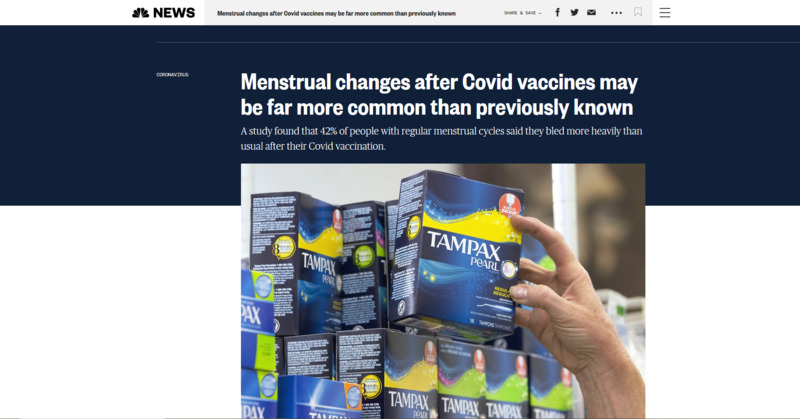 2022-07-15
2022-07-15Menstrual changes after Covid vaccines may be far more common than previously known
This is a news story from NBC News by Sarah Sloat. Since vaccines have been administered for the last year, new information has come out on how they effect the human body. The journal, Science Advances, found 42% of women with regular menstrual cycles bled more heavily after vaccination. 44% said no change occurred, while 14% reported lighter periods. There is no mention on if this side effect has any effect on fertility. -
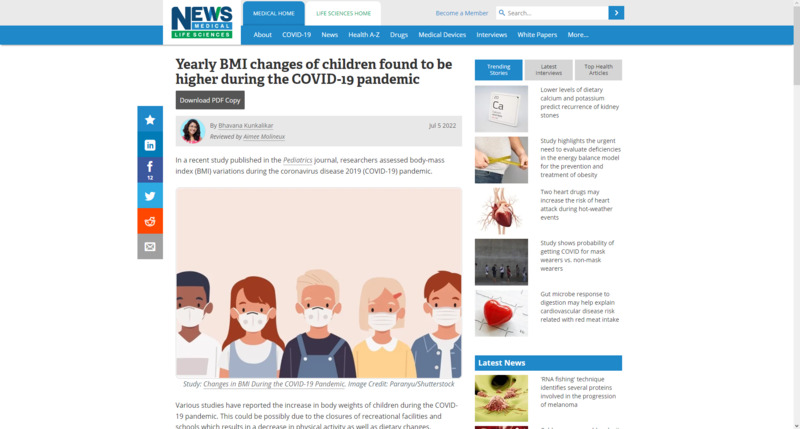 2022-07-05
2022-07-05Yearly BMI changes of children found to be higher during the COVID-19 pandemic
This is a news story from News Medical Life Sciences by Bhavana Kunkalikar. In a study published by the Pediatrics journal, researchers looked at the BMI variations during the COVID-19 pandemic. The study found that compared to the baseline measurements used pre-pandemic, the pandemic showed an increase in BMI that was .24 higher than the baseline. Higher rates of BMI increased in already obese children compared to children of a healthy weight. This article does not mention the social factors that would have contributed to weight gain during the pandemic, but not being able to socialize as often probably was a large contributor. From my own personal experience, I notice some people that I knew prior to the pandemic, and noticed that they put on some weight after the pandemic. Granted, this was what I noticed in adults I knew, not kids. Regardless, I believe that even if someone were to eat the same way they did pre-pandemic, but not exercise like they used to during the pandemic, they are bound to put on a bit of weight from lack of activity. Hopefully, with things being less restricted in some places, it will allow people to do things they did pre-pandemic more often and get back to healthier weights. -
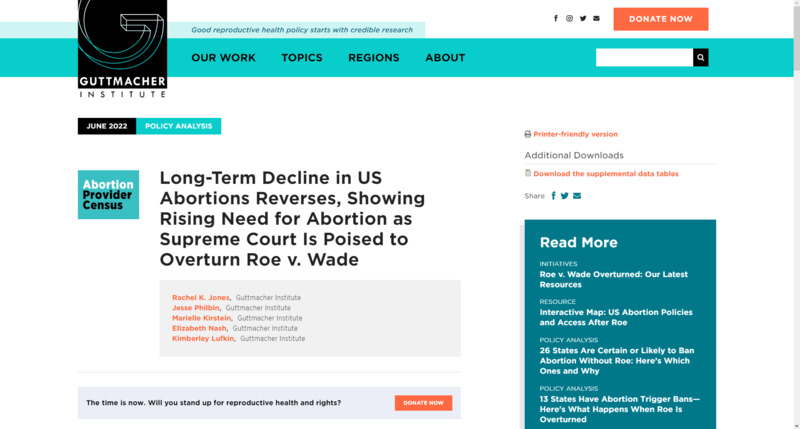 2022-06-15
2022-06-15Long-Term Decline in US Abortions Reverses, Showing Rising Need for Abortion as Supreme Court Is Poised to Overturn Roe v. Wade
This is a news story from The Guttmacher Institute. This article was written before the official Supreme Court decision was released on abortion. The article states that the 30 year decline in abortions has picked up with the threat of Roe v. Wade getting overturned. At the time this article is being entered in, Roe has been officially overturned by the Supreme Court. What is more interesting to me are the numbers given on abortions in 2020, when COVID was at its peak. In 2020, there was 930,160 total abortions, which was an 8% increase from 862,320 abortions in 2017. In 2020, about 1 in 5 pregnancies ended in abortion. The increase in abortions was marked in an overall 6% decrease in births between 2017 and 2020. The article does not discuss the social reasons why more abortions were happening in 2020 compared to other years, but in my own opinion, people's fears of hospitals being too full and the financial strain of lockdowns would have made it difficult to want to carry a baby to term. At the time, people were unsure of how long lockdowns and restrictions would last, so getting the pregnancy care needed to prevent issues giving birth would have been harder to come by. -
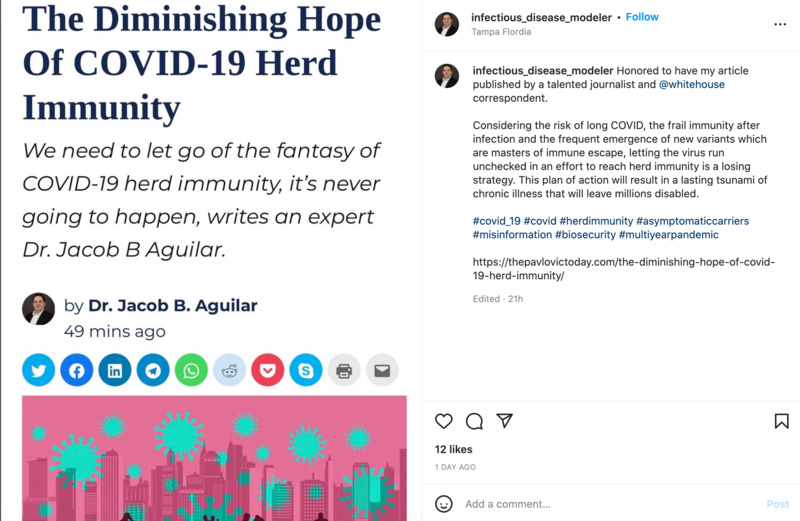 2022-06-16
2022-06-16The Diminishing Hope of COVID-19 Herd Immunity
This is an Instagram post from infectious_disease_modeler (Dr. Jacob B. Aguilar).He wrote an article about how herd immunity doesn't work with COVID as well as it could due to new variants that keep on happening. He says that if vaccines had a 100% effectiveness rates across all situations, this would not really be an issue. Since the vaccines are not entirely effective, the solution, Dr. Aguilar proposes that the way to help mitigate the issue is mass regular testing to slow the spread of new variants. -
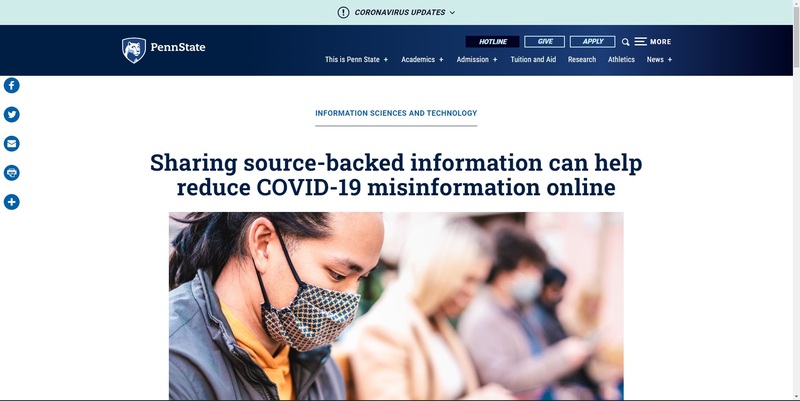 2022-06-09
2022-06-09Sharing source-backed information can help reduce COVID-19 misinformation online
This is a news story from Penn State University by Jessica Hallman. A recent study has shown that user corrections given back and forth on social media has helped reduce the spread of misinformation. Through sharing source-backed information, people were able to pick out fake news easier. -
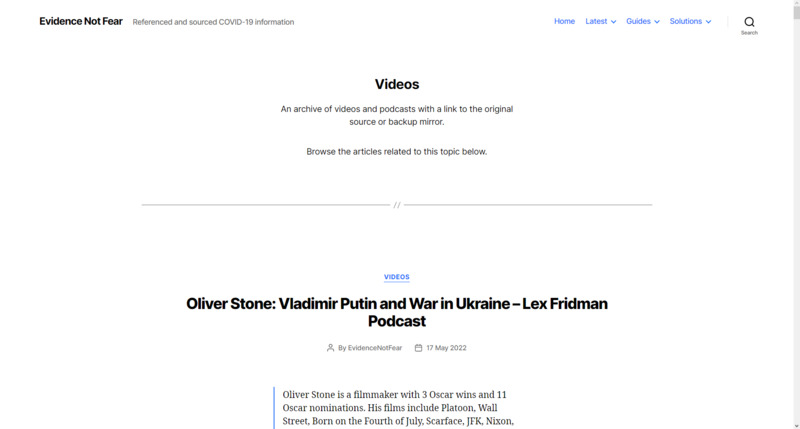 2022-03-09
2022-03-09The Pfizer Documents
This is a video regarding the safety of the Covid-19 Phizer vaccine reports that were recently released as of the making of both the video and this submission. It details the adverse events, the safe deliveries of the vaccine amongst an assortment of disorders, and the unhappiness of both the video creator and the viewers in the comments at the lack of transparency regarding the information surrounding the vaccine. -
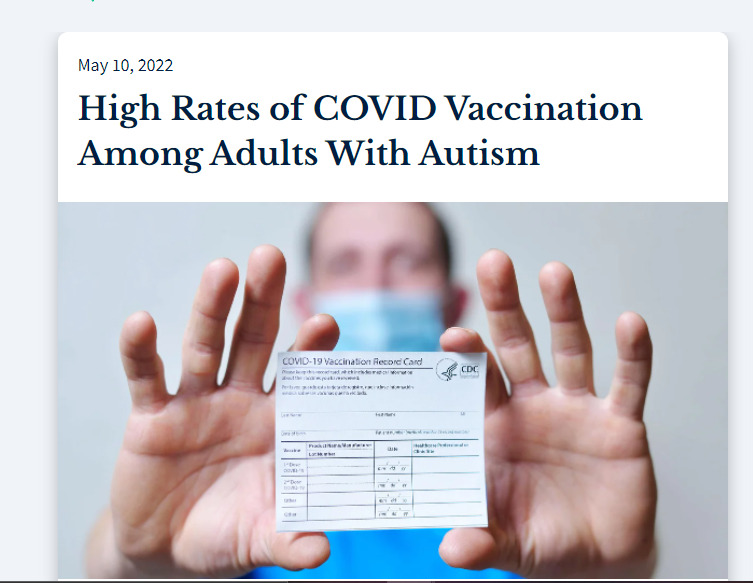 2022-05-10
2022-05-10High Rates of COVID Vaccination Among Adults With Autism
This is a news story from Health Day. Adults with autism have been shown to have higher rates of vaccination according to a new study. Those with autism are more at-risk for severe illness if they contract the disease, say researchers. To get the data, researchers sent online surveys to 431 autistic adults in Pennsylvania. They showed that about 78% of survey respondents said they had received or intended to get a COVID-19 vaccine, and more than 55% said that they had received at least one dose. In comparison, 42% of the overall adult population in Pennsylvania had received at least one dose of a COVID-19 vaccine as of the median response date for the survey (April 2, 2021), according to the study. The findings were published in the journal Vaccine. -
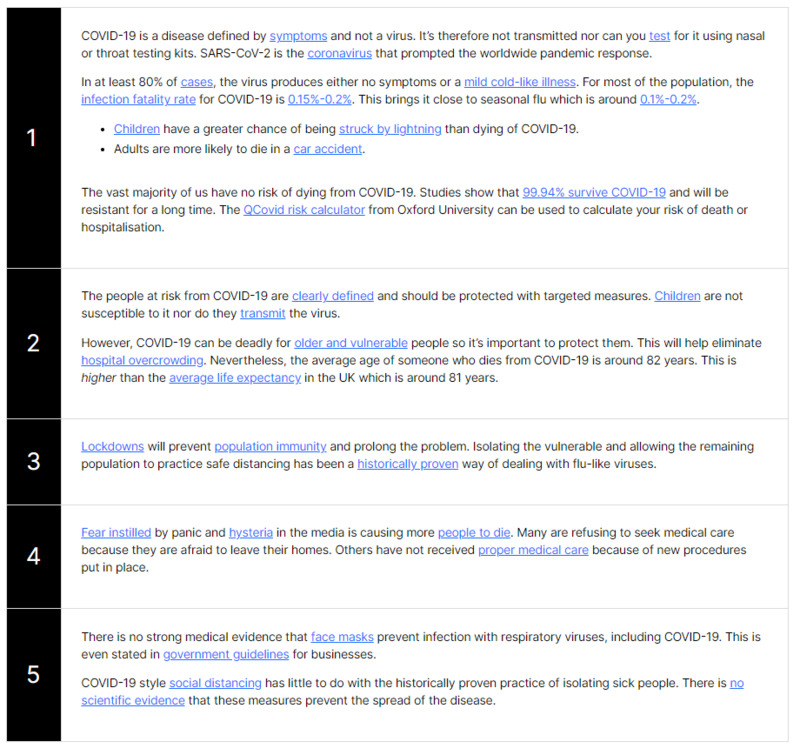 2022-05-10
2022-05-10Evidence Not Fear Key Facts Chart
The item is a chart from evidencenotfear.org. It can be found on the homepage. This chart can be found under the “key facts” section and explains the information that is claimed to be from experts in epidemiology, microbiology, and virology. The key facts section contains information that is immediately concerning to me. Some of the statements that are the most concerning to me are that children cannot transmit the virus, face masks can create negative health effects for the person wearing them, and more people have died from the panic of COVID-19 than the virus itself. The chart contains links, which I assumed would provide evidence and research to back up the claims. However, each link leads to an archive of news articles that are related to that topic. The message of this item is that the fear of COVID-19 has been worse than what the virus can actually do. This is seen through the explanations of face masks causing complications, lockdowns preventing herd immunity, and children cannot being affected by it. It tries to persuade the reader by providing links to several different news articles supporting the claim. However, the news article that they are using as support does not provide sources either. -
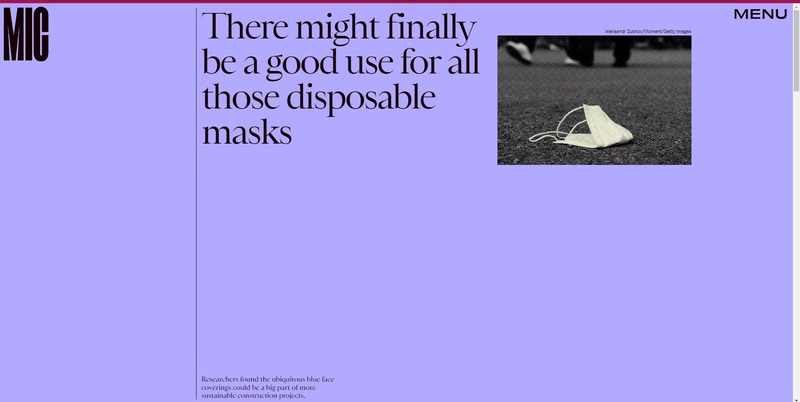 2022-04-28
2022-04-28There might finally be a good use for all those disposable masks
This is a news story from Mic by AJ Dellinger. A new study published in Material Letters has found that disposable masks could be used to help strengthen concrete. The concrete has tested out as 47% stronger than concrete than did not contain traces of masks. The reason it is stronger is due to the microfibers found in masks. Microfibers used in building materials have shown to reduce the amount fo cracks and shrinkage, which can happen within the first 28 days of laying concrete. Using disposable masks in concrete can help reduce mask pollution while making the concrete itself more durable. -
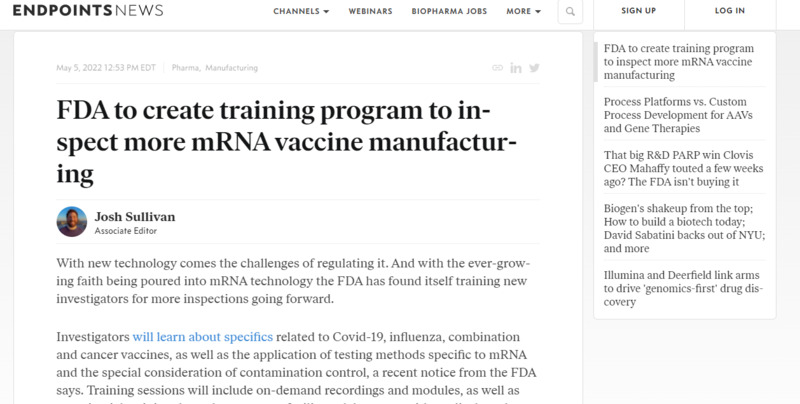 2022-05-05
2022-05-05FDA to create training program to inspect more mRNA vaccine manufacturing
This is a news story from Endpoints News by Josh Sullivan. With new faith being poured into mRNA vaccines, a new training program is being developed to help with the manufacturing process. This program will entail learning the application of mRNA vaccines, as well as laboratory training. BioNTech, Pfizer’s partner in its Covid-19 vaccine efforts, recently revealed that it is paying Matinas BioPharma to gain exclusive access to its lipid nanocrystal drug delivery platform for the oral delivery of mRNA. It also was one of the first companies to announce plans for the massive mRNA manufacturing sites that are being built. BioNTech plans to piggyback off the success of the technology by pivoting to work on malaria vaccines once the Covid-19 pandemic has subsided. -
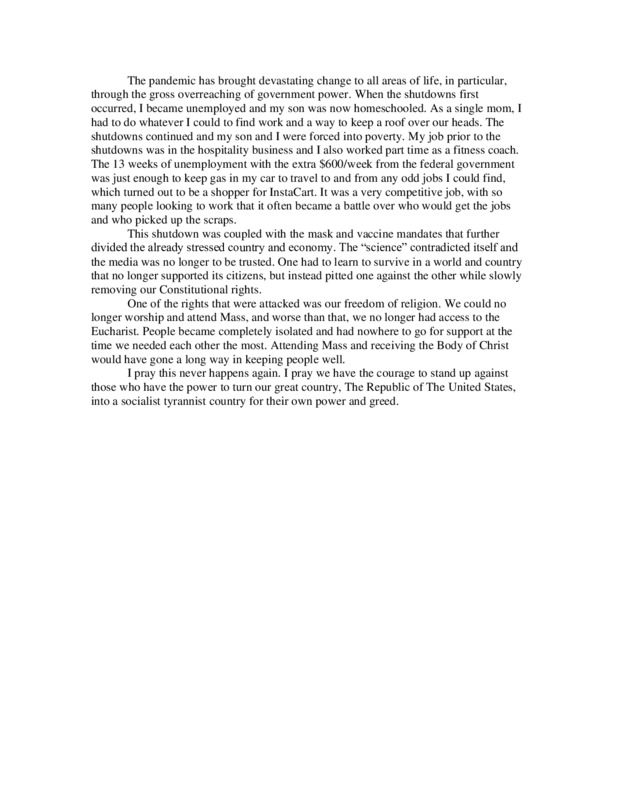 2022-04-27
2022-04-27Poverty and the Pandemic
My story touches on the importance of who holds the power over your life. Ultimately it is written to give an account to future generations so we never go back there again. -
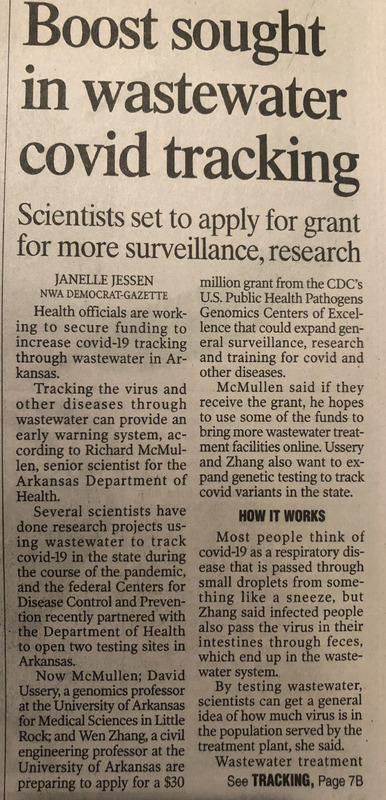 2022-04-10
2022-04-10Boost sought in wastewater covid tracking
This is a news article detailing the work of health officials and scientists and a new program of tracking COVID in wastewater through a program at the University of Arkansas. The Arkansas Department of Health hopes this new program will allow scientists and health officials to receive an early warning about a potential surge in the spread of COVID and take appropriate measures to minimize the potential damage. If successful, the University and the Arkansas Department of Health hope to apply for a $30 million dollar grant from the CDC to implement the process across the country and perform more research. The basic premise is to collect a sample of wastewater and test for COVID-19 and thereby generally derive if the community is increasing or decreasing in cases. While the program cannot give a specific number of afflicted individuals, it is suggested that understanding COVID in wastewater will give health officials a better understanding of those who test at home and therefore do not report on state-wide numbers. This article is fascinating, I think, because it demonstrates a rapid growth in scientific ideas to combat the pandemic since the dawn of COVID in America. Indeed, COVID has permeated every aspect of our lives, so it is only natural to derive a solution from even the most mundane aspects of humanity. It would seem impossible to gain a greater understanding of COVID from something such as wastewater, but the pervasiveness of COVID has encouraged study such as this. I think the ultimate mission of this program is valuable. When I had COVID at the start of February, I took an at home test and therefore I was not reported as a number in the statewide totals. This article really made me think about whether or not we as a society really know how many people are afflicted with COVID and just how serious the pandemic is or not. This article was published in the Northwest Arkansas Democrat Gazette. -
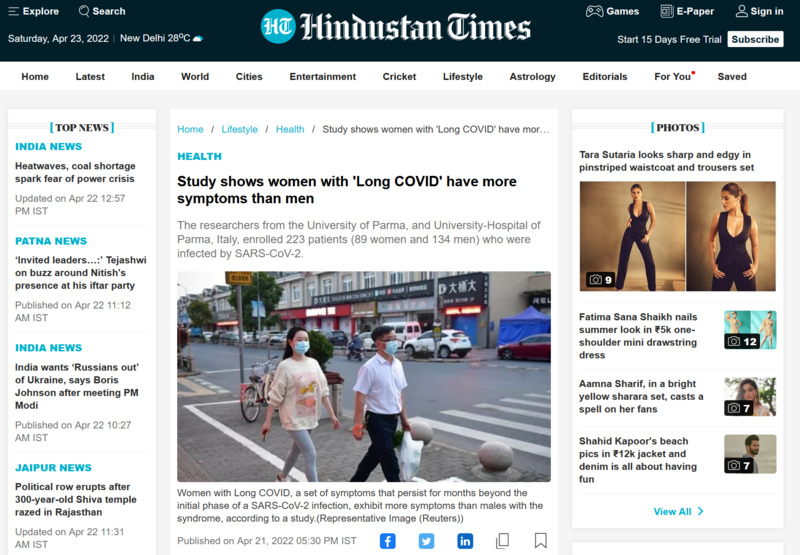 2022-04-21
2022-04-21Study shows women with 'Long COVID' have more symptoms than men
This is a news story from the Hindustan Times. There has been a study showing that women tend to be affected more by 'Long COVID' symptoms than men do. The research was published in the Journal of Women's Health. In the study, women are more likely to have fatigue, difficulty swallowing, and chest pain after a COVID infection compared to men. -
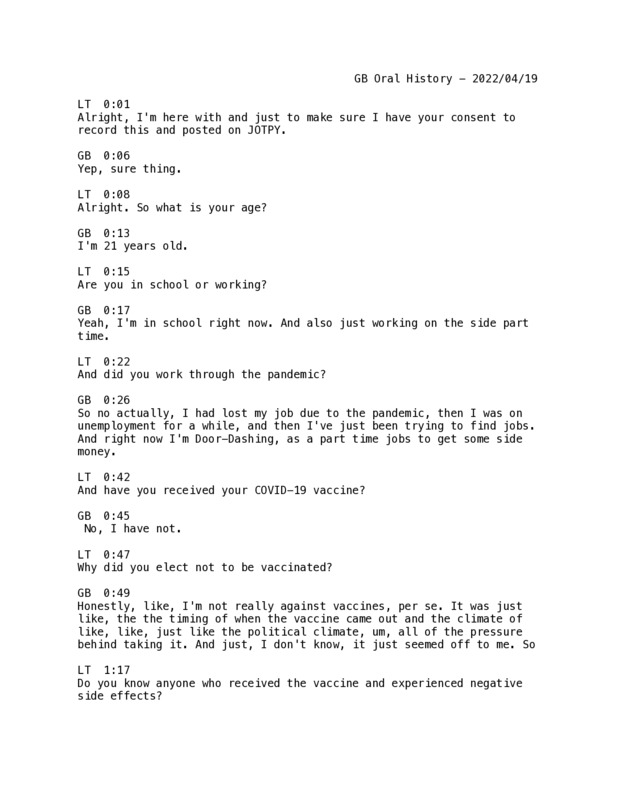 2022-04-19
2022-04-19GB Oral History, 2022/04/19
The interviewee discusses vaccine hesitancy and life during the pandemic without having received the vaccine. -
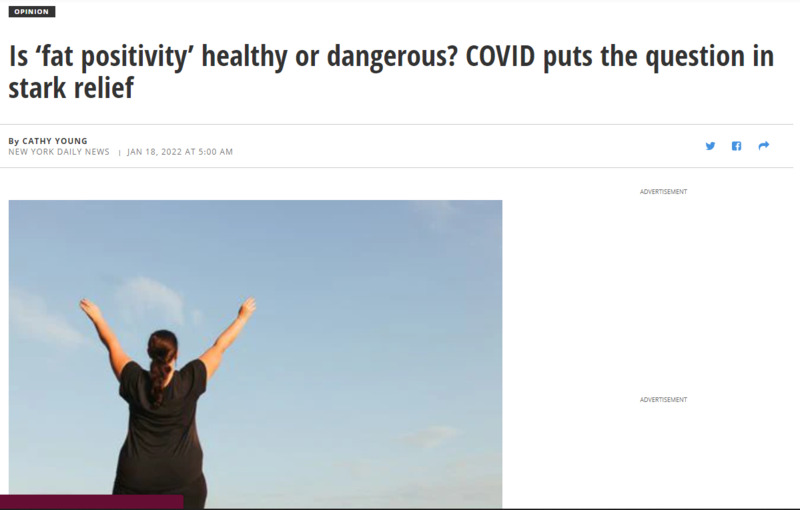 2022-01-18
2022-01-18Is ‘fat positivity’ healthy or dangerous? COVID puts the question in stark relief
This is a news story from New York Daily News by Cathy Young. This is an opinion piece questioning what body positive activists have been claiming about obesity and COVID, with many claiming weight has little to no effect on recovering from COVID. Quoting the CDC, Young says that obesity puts people at greater risk of dying from COVID than those of normal weight. Other parts of this opinion piece deal with the language surrounding the body positive movement, and how there is no distinction made between listening to medical advice and getting harassed. The author says that this is a major issue because it makes it so people reject sound medical advice at the expense of their own health. She says that while outright harassment is cruel, genuine concern and wanting people to improve their well-being is not. There is also criticism towards feminist writers in this article, such as Kate Manne, a philosophy professor from Cornell University, that claims all dieting is "morally bad." Young acknowledges that dieting can be unhealthy, but it is not unhealthy in and of itself. She thinks that if you have realistic goals, maintaining a healthy weight is not impossible. At the end, Young explains that this body positivity movement is destructive towards people, and that those struggling with weight issues should be met with compassion, but not "acceptance." This essay shows some of the social impacts of COVID. With some people reporting weight gain during lockdowns, it is easy to see why body positivity would be encouraged as a result. Though, since obesity puts one at higher risk for more complications with COVID, or any other disease for that matter, it should not be encouraged, in my own opinion. It is one thing to be shaped differently, it is quite another to accept being obese when it poses many health risks. -
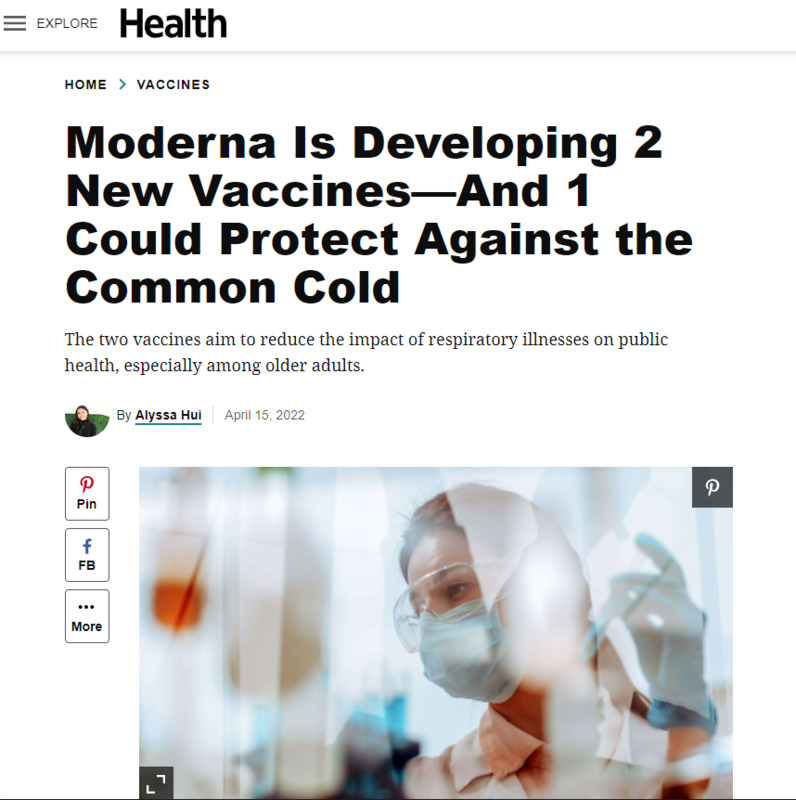 2022-04-15
2022-04-15Moderna is Developing Two New Vaccines-- And One Could Protect Against the Common Cold
This is a news story by health.com written by Alyssa Hui. This story is about Moderna expanding its biotechnology into creating new vaccines using similar techniques the COVID vaccines have used. One of these vaccines will be used to help combat RSV, which is a virus that hospitalizes an average of 177,000 adults per year, according to the CDC. Another illness that Moderna is looking to use vaccines against are four other endemic human coronaviruses. Moderna does not claim they offer 100% guaranteed protection, but that they can benefit people greatly for reducing chances of contracting certain illnesses. Moderna wants to ensure that the vaccines are safe and will go through testing procedures to do so. They are hoping that there will be more uses for mRNA style vaccines in the future, and not just for the coronavirus. -
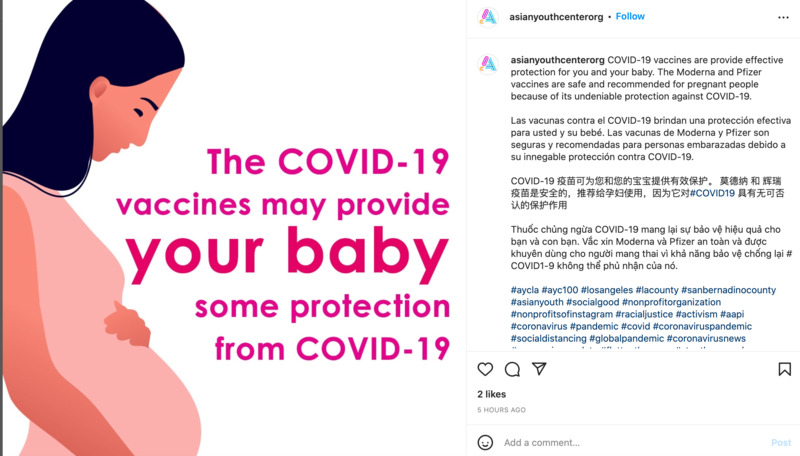 2022-04-14
2022-04-14COVID-19 Vaccines May Protect Your Baby
This is an Instagram post by asianyouthcenterorg. This post is giving information on vaccinations and pregnancy. It says that Pfizer and Moderna are the most recommended vaccines for expecting mothers. -
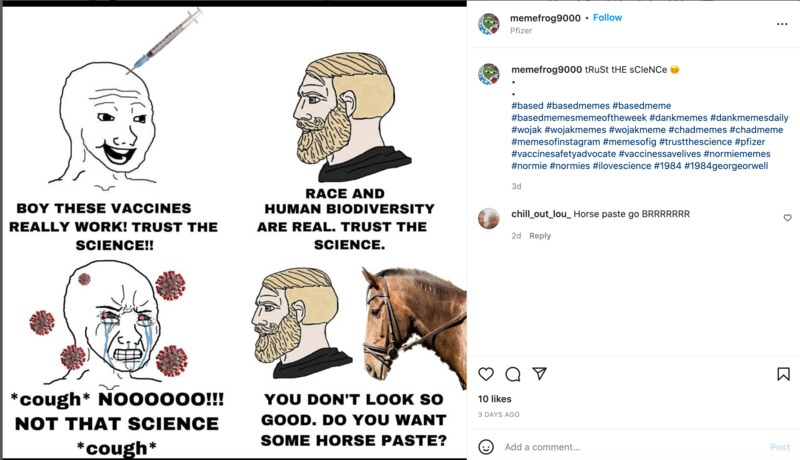 2022-04-04
2022-04-04Trust the Science
This is an Instagram post by memefrog9000. This is another meme where it depicts a soy wojak (the wojak on the left) and the Chad wojak (the wojak on the right with the blond hair). This meme is making fun of people like the soy wojak that "trust the science", only later to get the virus despite getting vaccinated. The Chad wojak then suggests the soy wojak use some "horse paste" to help. "Horse paste" refers to Ivermectin, which is used to treat horses. There has been controversy if Ivermectin does treat COVID, or other things in humans for that matter, but the FDA currently recommends against it. -
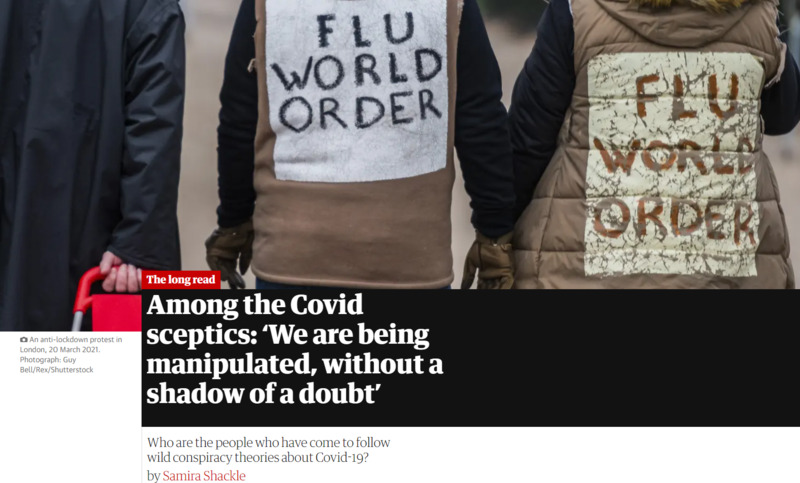 2021-04-08
2021-04-08Did COVID doubters' perspective get lumped in with deniers?
I believe we all know someone during the worst days of the pandemic who doubted that it was as serious as it really was. Perhaps they willingly discussed their perspective, reluctantly talked about it if pressed, or just did not even want to talk about it. I am not talking about the people seen in the attached article that were out protesting masks or vaccines, pushing conspiracy theories on 5G and Bill Gates' love of vaccines. I am thinking of the people we work with, are friends with, or very likely are in our families that just really just wanted life back to normal and did not think the global reaction was justified. A casual search of the internet for the perspectives of COVID doubters, or those who thought that the reaction to the pandemic was over-the-top, immediately sends you to articles and stories about the horrors and idiocy of the COVID deniers who pushed crazy theories about world dominance. Wouldn't it be nice to understand how the middle ground of the pandemic felt, lived, and reacted to the reality of the pandemic, if at all? We owe it to future generations to not only highlight the worst in the deniers, as seen in the attached article, but to also illustrate the everyday people who just were not sure who to believe, fake news or science. One thing is for sure, it is not fair to lump everyone in the middle into the far right. I would like to hear the stories of people who doubtfully lived in the pandemic, their trials, frustrations, and tribulations and if they had any change of heart or ideals. Their perspective will give a further understanding of the sociological impact of the pandemic. -
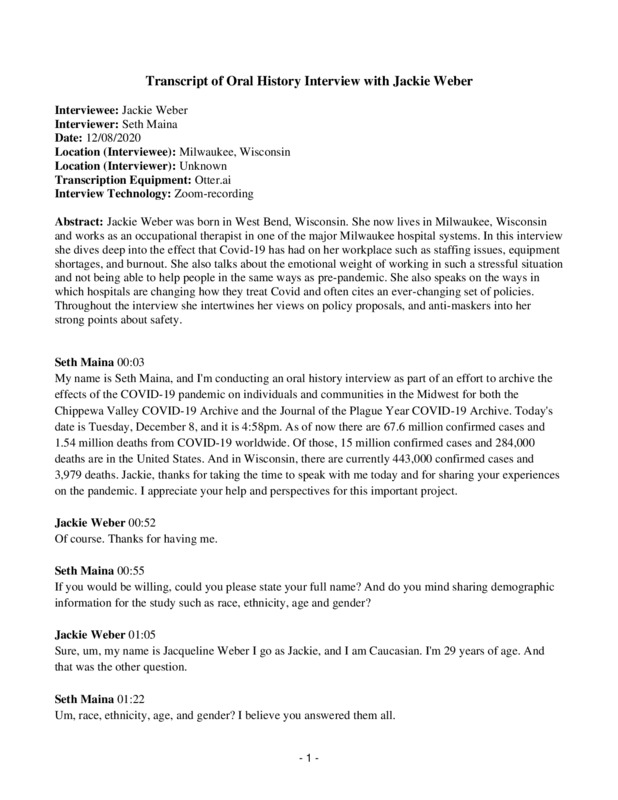 12/08/2020
12/08/2020Jackie Weber Oral History, 2020/12/08
Jackie Weber was born in West Bend, Wisconsin. She now lives in Milwaukee, Wisconsin and works as an occupational therapist in one of the major Milwaukee hospital systems. In this interview she dives deep into the affect that Covid-19 has had on her workplace such as staffing issues, equipment shortages, and burnout. She also talks about the emotional weight of working in such a stressful situation and not being able to help people in the same ways as pre-pandemic. She also speaks on the ways in which hospitals are changing how they treat Covid and often cites an ever-changing set of policies. Throughout the interview she intertwines her views on policy proposals, and anti-maskers into her strong points about safety. -
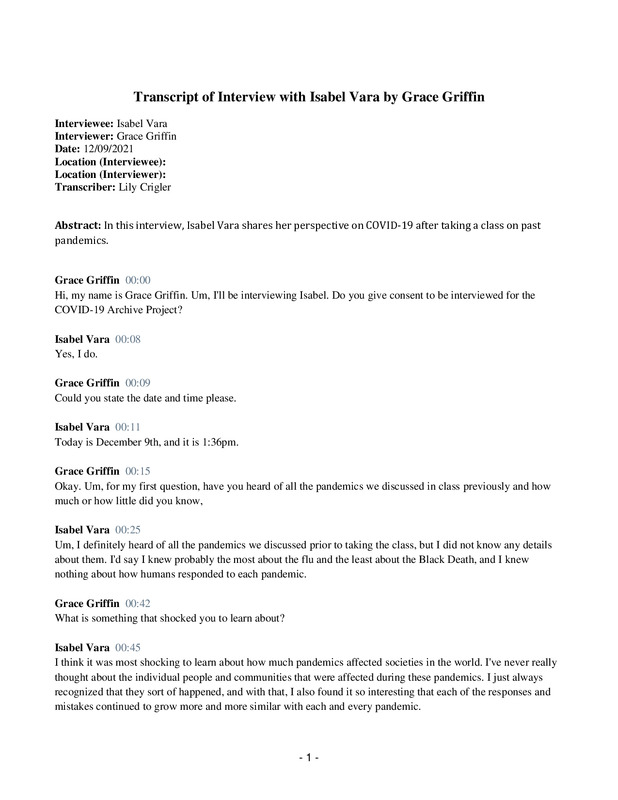 2021-12-09
2021-12-09Isabel Vara and Grace Griffin Oral History, 2021/12/09
The audios I have uploaded share different perspectives on Covid-19 after learning about past pandemics -
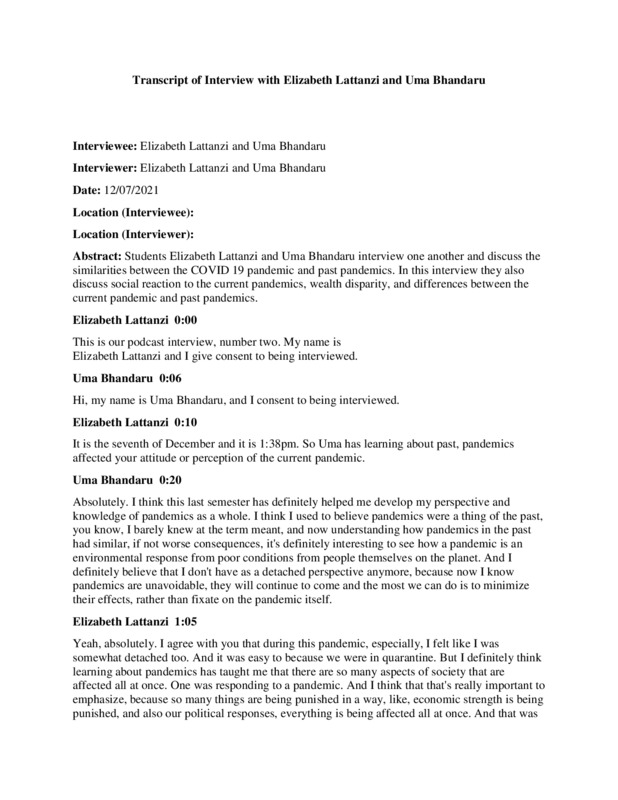 2021-12-07T13
2021-12-07T13Covid-19 Archive Project Second Interview
After learning about four major pandemics, we discussed how our views of the COVID-19 pandemic have changed over the course of the semester, and how our perceptions of pandemics as a whole have changed. -
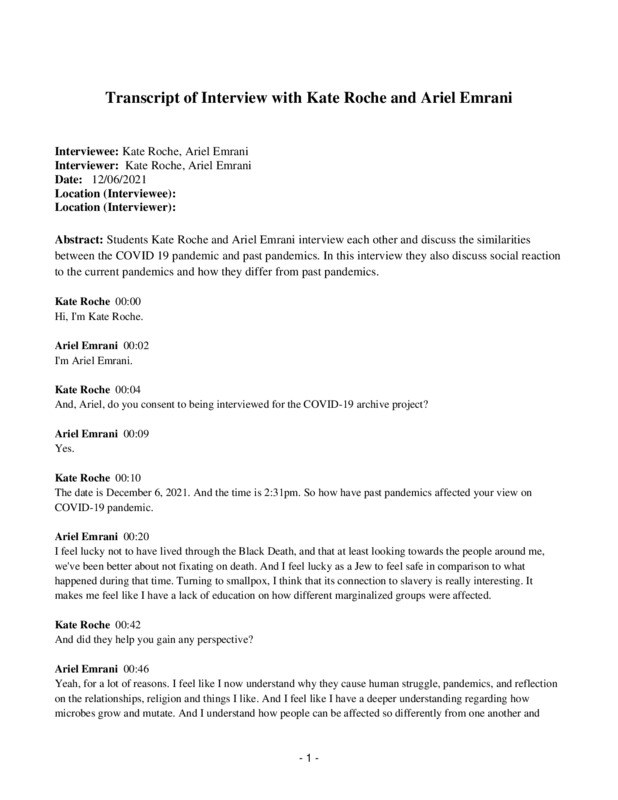 2021-12-06
2021-12-06Kate Roche and Ariel Emrani Oral History, 2021/12/06
It explains how past pandemics have affected how we view COVID-19. -
 2021-08-24
2021-08-24The proof is(n't) obvious.
Memes denoting the deep irony of our current moment in time seem to have become very popular since the start of the pandemic. Early on, someone used this meme to draw a comparison between the developing movement of people who claimed that COVID-19 was/is a hoax, and that refuted data by mere denial. -
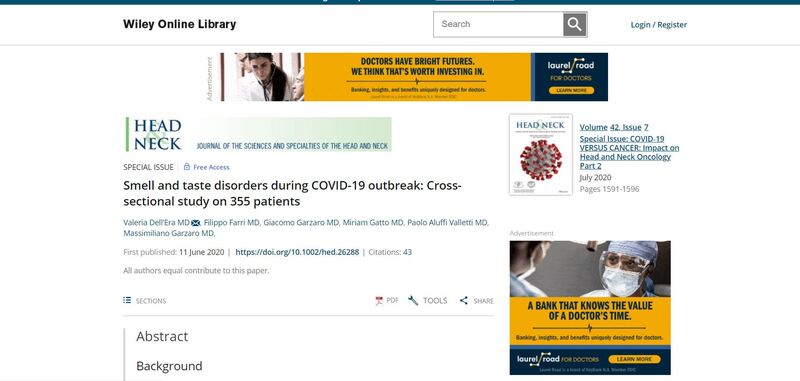 2020-05-12
2020-05-12Smell and taste disorders during COVID‐19 outbreak: Cross‐sectional study on 355 patients, Dell’Era, Valeria ; Farri, Filippo ; Garzaro, Giacomo ; Gatto, Miriam ; Aluffi Valletti, Paolo ; Garzaro, Massimiliano, 2020 (Hoboken, John Wiley and Sons, Inc. Head & neck, 2020-07, Vol.42 (7), p.1591-1596).
2. Description: Among the most commonly observed effects of Covid-19 on patients are deteriorations (temporary or permanent) of taste and smell (Dell’Era et al. 2020, p. 1591). During the Italian Covid-19 outbreak in 2020, Novara University Hospital conducted a cross-sectional study examining the extent of smell-and-taste related disorders among patients confirmed to have contracted the virus. Results from the study suggest that an overwhelming share of patients experience sharp alterations in both senses, the severity of which differs from subject to subject. While extreme symptoms disappeared a fortnight after subjects participated in the study, a portion of respondents reported lingering sensory effects resulting from the virus (Dell’Era et al. 2020, pp. 1591-96). -
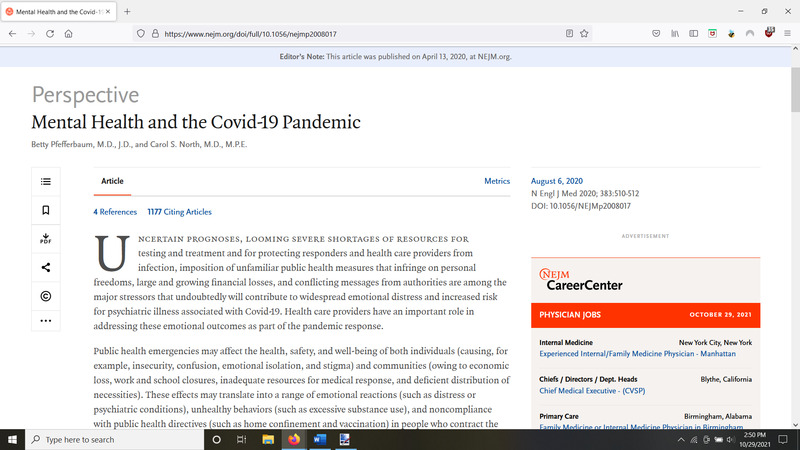 2020-04-13
2020-04-13Mental Health and the Covid-19 Pandemic
Uncertain prognoses, looming severe shortages of resources for testing and treatment and for protecting responders and health care providers from infection, imposition of unfamiliar public health measures that infringe on personal freedoms, large and growing financial losses, and conflicting messages from authorities are among the major stressors that undoubtedly will contribute to widespread emotional distress and increased risk for psychiatric illness associated with Covid-19. Health care providers have an important role in addressing these emotional outcomes as part of the pandemic response. -
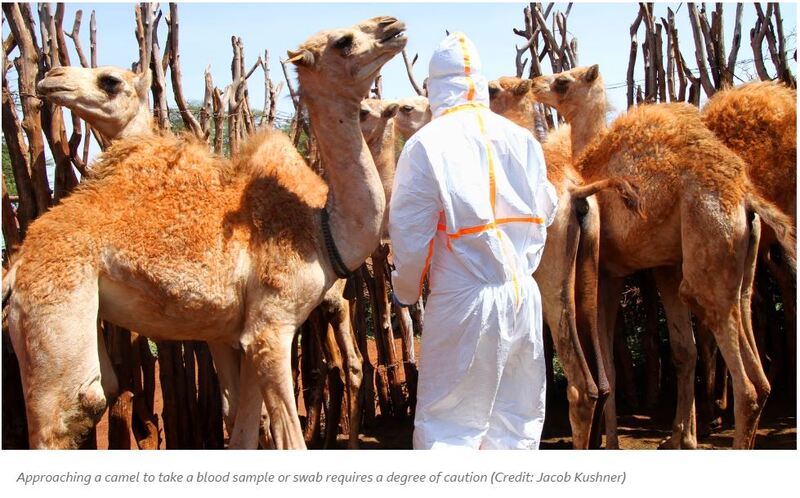 2021-01-25
2021-01-25Why camels are worrying coronavirus hunters
In northern Kenya, researchers are working to prevent a dangerous coronavirus – Mers – from jumping from camels to humans again. But climate change is making their job more difficult. I It’s thought that Covid-19 originated in animals before jumping to humans. Now experts are warning that the chances are the next pandemic will, too. Seventy-five percent of the newly emerging diseases currently affecting people originate in animals, according to Predict, a US government-funded collaboration by infectious disease experts across the globe. Already, Predict scientists have identified 1,200 new zoonotic, or animal-borne, diseases. But scientists estimate there are some 700,000 more zoonotic diseases we don’t even know about yet. ... “That infection” is Middle East respiratory syndrome (Mers), a novel coronavirus that so far has proven to be at least 10 times more deadly than Covid-19. It was discovered in Saudi Arabia in 2012. By 2016, the World Health Organization (WHO) had identified “1,761 laboratory-confirmed cases of infection with Mers-CoV, including at least 629 related deaths”. Later that year, an outbreak at a hospital raised the alarm that it’s not just camel herders who are susceptible to the disease, but anyone at all. But while camels can be carriers, the Mers threat to humans is mostly man-made. As human-induced climate change makes droughts more frequent, prolonged, and severe, herders have had to abandon cows and other livestock for camels because only they can survive weeks without water. The result is a growing number of camels in close contact with humans – the perfect conditions for the spread of a deadly disease. Mers causes the same sorts of respiratory system complications as Covid-19, including pneumonia. Symptoms often start with nasal congestion, a cough, chest pains, or difficulty breathing. In the worst cases, it may cause fibrosis – irreversible scarring – in the lungs. This can be deadly. More than one-third of all humans known to have contracted Mers have died from it, according to the WHO. Once it jumps from animals to humans, a Mers outbreak could grow rapidly. Saudi Arabia alone saw 15 people infected in December 2019 and January 2020 – three of whom were hospital workers infected by their patients. “The fact that RNA viruses such as coronaviruses mutate means you never know what could happen with that particular virus,” says Zimmerman. -
2021-07-28
A trip to Central America
My family recently went on our first trip since before COVID. My husband is an ER doctor in Los Angeles and saw how the pandemic ravished our city. Getting away was necessary for all of our mental health. We were all vaccinated and tested before going and then tested again before coming back. I remember an interesting conversation with some locals that I wanted to share with the archive. While talking about the pandemic with some locals my husband was asked about his thoughts on the vaccine. He said he trusted the work of the scientists who developed the vaccine and he trusted the CDC enough to get it. The locals let him know they were not vaccinated and were not planning on it because of the side effects they had heard of. The first being that those who were being vaccinated faced possible death within the first two years. My husband politely said he had been vaccinated and felt very much alive. The second one was that it caused homosexuality. I wasn’t sure if I should be sad or surprised at that one. Such great ignorance over a vaccine that has already saved so many lives. -
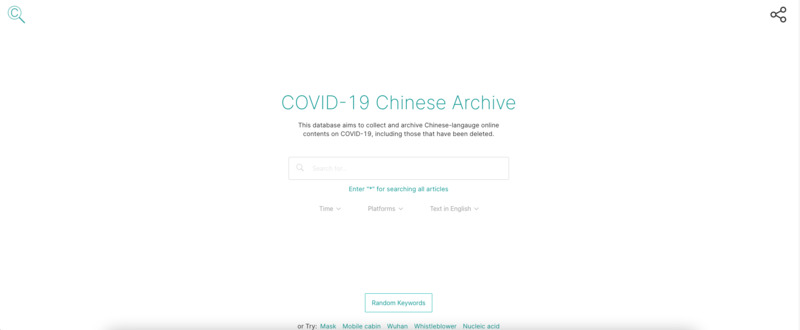 2019-01-01
2019-01-01COVID-19 Chinese Archive
This database aims to collect and archive Chinese online contents on COVID-19, including those that have been deleted. The platform is built as a search engine in English, it can be used by world-wide researchers to conduct further study about the COVID-19 in China. -
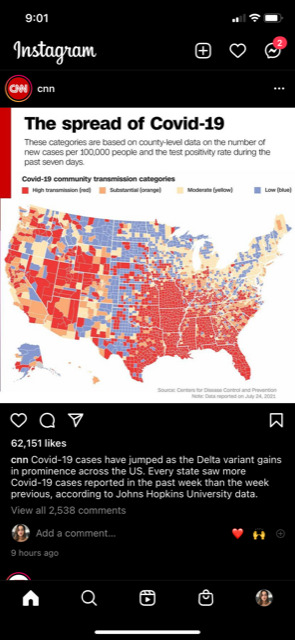 2021-07-28
2021-07-28The spread of Covid-19
"cnn Covid-19 cases have jumped as the Delta variant gains in prominence across the US. Every state saw more Covid-19 cases reported in the past week than the week previous, according to John Hopkins University data." -
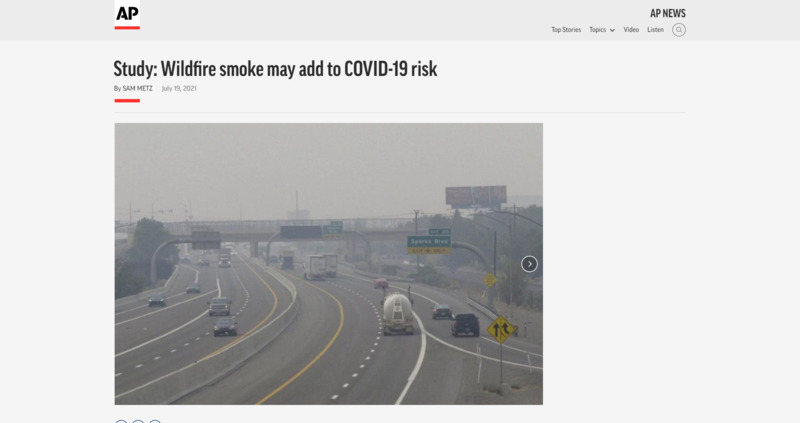 2021-07-19
2021-07-19Wildfires and COVID
This article from the Associated Press discusses a study done by Nevada-based scientists, that have found a correlation between wildfire smoke and positive COVID cases. The study showed that "for every 10 micrograms per cubic meter of small particulate matter known as PM2.5 in the air, the positivity rate increased about 6.3% two to six days later". The study acknowledges, however, that the uptick in cases may be from other factors, such as a second surge, or students going back to school. Although further studies are required, the study done by the Nevada scientists may suggest that higher pollution levels can make people more prone to viruses. -
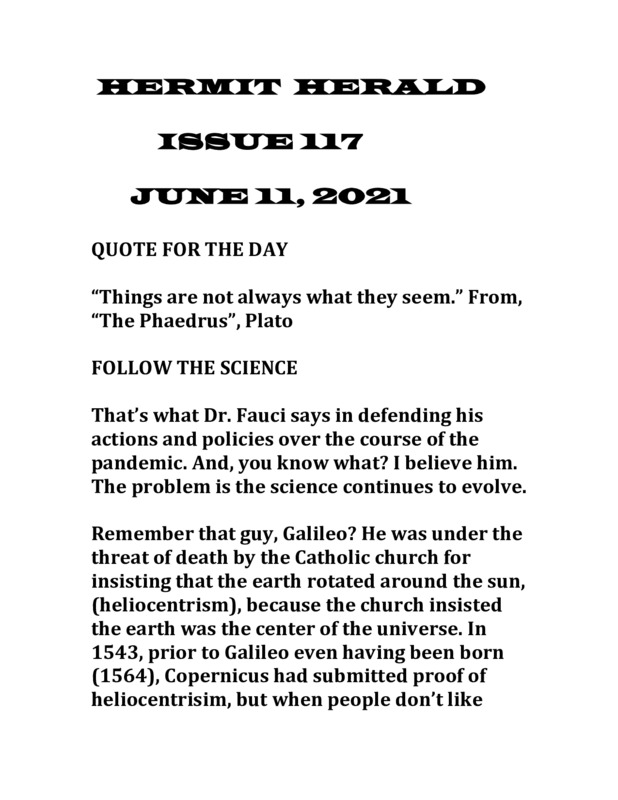 2021-06-11
2021-06-11hermit HERALD, ISSUE 117
COVID 19 AND EVOLVING SCIENCE -
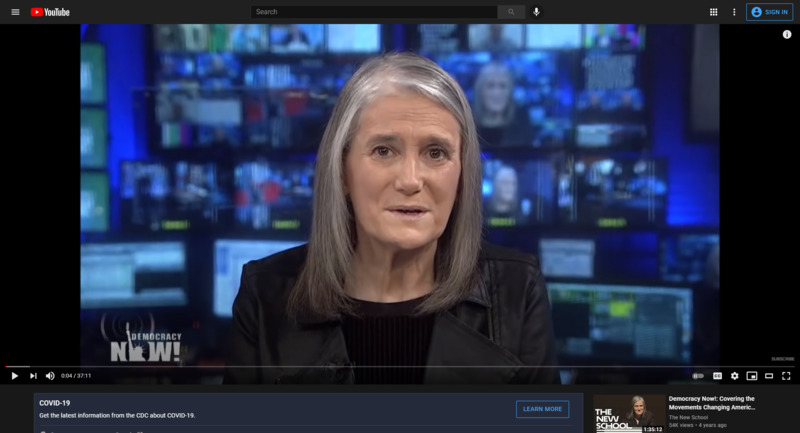 2020-03-18
2020-03-18How Will COVID-19 Change the World? Historian Frank Snowden on Epidemics From the Black Death to Now
This video is an interview the Democracy Now did with Frank Snowden, Professor Emeritus at Yale University early on in the pandemic (March 18, 2020). Dr. Snowden specializes in the history of epidemic diseases and the history of modern Italy. His father was the first African American ambassador to Italy. At the time of the interview, Dr. Snowden was in lockdown in Rome, Italy. He had gone there to research another project when the pandemic hit, so he changed his focus to studying covid-19. He contracted the disease himself, but was lucky enough to live through it. I was particularly interested in Dr. Snowden's views on the pandemic since I had watched his Yale lecture series on epidemics available on Youtube (https://www.youtube.com/playlist?list=PL3AE7B3B6917DE8E6) which was incredible in its thorough exploration of some of the worlds worst outbreaks. In the interview he states that an early modern Florentine would recognize a lot of governments' actions to combat covid-19 as very similar to those used by the Italian city-states and elsewhere in Europe to combat bubonic plague, especially the concept of quarantine. He also addresses the startling commonality between anti-Semitism during the first several plague outbreaks to the Sinophobia and xenophobia seen during our current pandemic. The interviewer also brings up a great question about the possibility of fascism arising out of strict government measures to combat disease. I was particularly curious to hear Dr. Snowden's response in light of the protests in the United States against quarantine and mask-wearing. He acknowledged that while it could be one outcome, it is not the only nor the most probable possibility. Many governments have voluntarily ended their strict measures during pandemics without devolving into fascist states. Now that the pandemic is, it seems, waning I believe it is abundantly clear that those Americans who feared that their freedoms were threatened by historically proven practices were both selfish and foolish. They and our ineffective and dangerous leadership cause the United States to become a hotbed for Covid-19, while other countries who swiftly enacted and enforced lockdown measures and mask mandates, such as New Zealand and Italy, recovered much more quickly. I contend that Donald Trump and his sheep are responsible for thousands of unnecessary deaths. -
 2020-09-17
2020-09-17Environmental effects of COVID-19 pandemic and potential strategies of sustainability
The article discusses the positive and negative effects of the COVID-19 pandemic on the environment and climate and proposes possible strategies for global environmental sustainability going forward. The open-access article is posted on the U.S. National Institutes of Health website. -
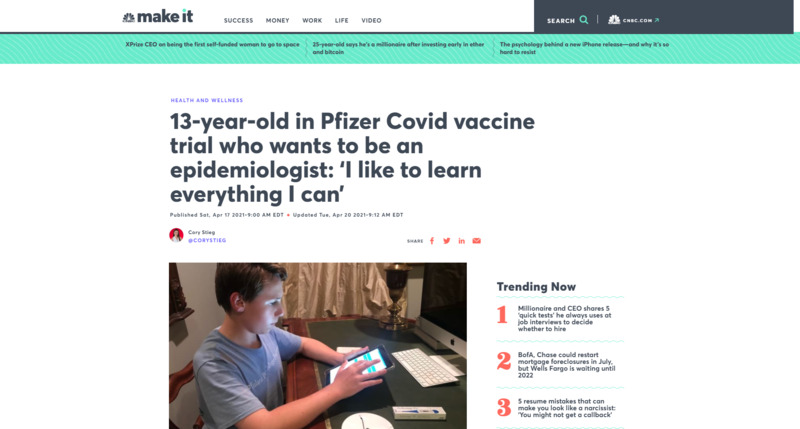 2021-04-17
2021-04-1713-year-old in Pfizer Covid vaccine trial who wants to be an epidemiologist: ‘I like to learn everything I can’
Recently CNBC has released an article on my story in the Pfizer Vaccine Trial. I got interviewed about a week ago, and I helped in the making of the article. It is on a division of CNBC called CNBC Make It. CNBC Make It is a section of CNBC that specializes in money, wellness, and heartwarming stories. I have gotten to know the writer, Cory Stieg, well and it was great working with her. The article goes into detail about how the trial works and my experience with the trial. This experience has been amazing from both ends, Pfizer and CNBC. I hope that I inspired others to make a change in the world and to try and pursue your passions. Link to article in description -
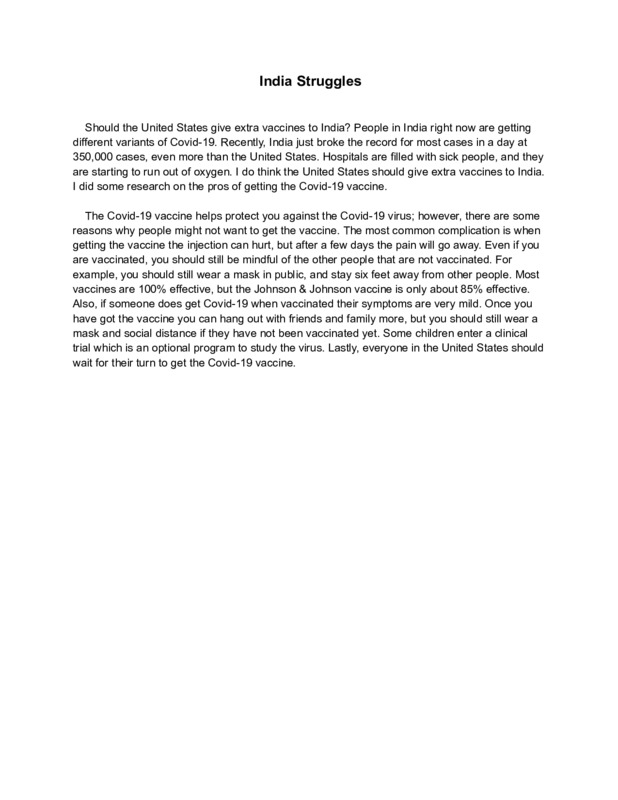 2021-04-26
2021-04-26India Struggles
I discussed the Covid-19 crisis in India. As the United States improves and cases go down, India needs a lot of assistance. -
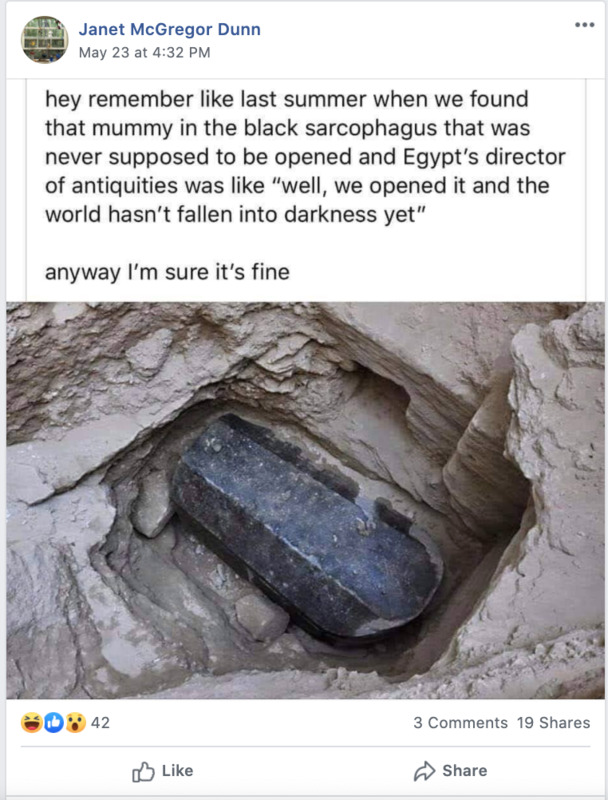 2020
2020Uncovering long-forgotten and buried artifacts during Covid time
The plague of COVID-19 descended upon us in 2020. People created humorous memes and joked that this year wouldn't be the right time to unearth hidden mummies or other mysterious long buried. Who knows what might happen next? Best to avoid. Enough's enough. -
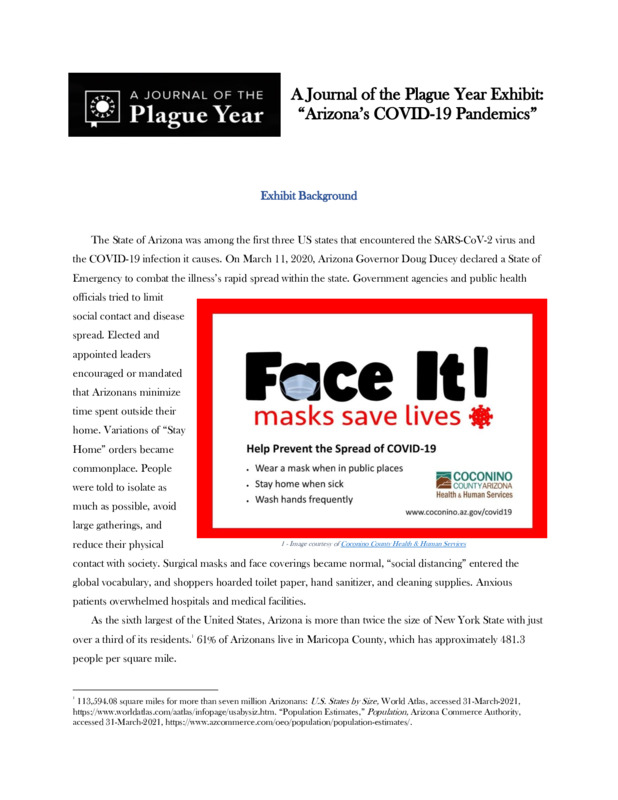 2021-04-20
2021-04-20JOTPY Exhibit: "Arizona's COVID-19 Pandemics" by James Rayroux
While working as a curatorial intern on ASU's 'A Journal of the Plague Year' COVID-19 archive, I created this exhibit on the pandemic experience within the state. In addition to obvious, overarching realities such as socioeconomic status and immediate access to healthcare systems, I initially believed one of the greatest deciding factors that determined one's experience in Arizona was an individual's residence in either predominantly urban or rural environments. The proposed exhibit had been originally titled "A Tale of Two Arizonas" to pay respect to Charles Dickens and the differing realities experienced here. To test my proposed hypothesis, I went about finding data, stories, and submissions that substantiated or disputed my premise. Within a short time, I had identified four distinct environmental drivers of personal pandemic experiences; to me, that indicated the existence of many more I hadn't yet found or had overlooked along the way. My evidence suggested a minimum of four pandemic locales: Urban, Rural, Border, and Tribal within the State of Arizona and its fifteen counties. The recorded health data and personal experiences demonstrated the naivete of my initial hypothesis, and I retitled the exhibit: "Arizona's COVID-19 Pandemics." The Exhibit Background section illustrates the vast dichotomies within Arizona in terms of population density and access to healthcare facilities. Given the virus's respiratory nature, these factors seemed especially relevant to driving diverse local experiences. I chose to include a flyer from the Coconino County Health and Human Services' "Face It! Masks Save Lives" campaign. The flyer included a specific line to "Stay Home When Sick" that seemed to illustrate a different public health paradigm than the broader "stay home" orders from Maricopa and Pima county. This section also features an image of Sedona's red rocks and a portion of The Wave to remind visitors of the wide-open rural areas accessible to all, as well as those with cultural significance to the Native American tribes and limited access to the general public. The next section asks a short, five-question survey in which visitors may participate. The Silver Linings piece features a short audio clip of a father and husband discussing some unexpected benefits of the pandemic. Visitors may explore additional Silver Linings stories and submit their own experience. The Tséhootsooí Medical Center piece seeks to illustrate the different pandemic experience on the state's tribal lands. I hoped to inspire some relevant emotional turmoil for the visitors through the piece's visual presentation. I wanted to create a series of waves with quotes from the medical center's healthcare workers. I hoped visitors' attention would be drawn to the large, bolded key words, and that they would first experience the segments out of sequence because of that. After potentially feeling a sense of chaos, they might settle themselves into a deliberate reading of the texts and find their own order within the experiences provided here. This piece allows further exploration of Native submissions and topics, a review of an additional related news article, and a submission prompt that invites visitors to offer guidance to hospital managers. The next piece illustrates the differences between mask mandates in communities across Arizona. In addition to hearing an audio clip of interviews with mayors and a public health official, visitors can explore additional submissions related to mask mandates and submit their thoughts on statewide mandates. The Arizona Department of Health Services provides zip-code specific infection data on its website, and the wide array of known case infections therein further illustrates potential dichotomies across the state. In working to include and represent this data in a consumable way, I encountered inconsistencies with tribal data. The nation's Indian tribes are overseen by Indian Health Services, a federal public health agency, and it does not collect or report data in the same manner as the State of Arizona or its counties. At first glance, the data would seem to suggest that tribal areas had less severe pandemic experiences than the rural and urban areas, which was not objectively true. I wanted to offer the unedited data to visitors, allow them to drawn their own conclusions, and invite them to offer their thoughts on what potential misunderstandings might emanate from these reporting differences. Visitors may also choose to review the foundational data from this piece, as well. I used the following two sections to offer submission prompts about the visitor's overall pandemic experience as a function of their location, as well as what they might have done if placed in charge of their city, county, or state during this pandemic. A diverse Search section allows visitors to explore additional topics of interest to them. 23 hyperlinks offer pre-defined search parameters. An Advanced Search link allows self-defined research, and a Join The Staff link connects visitors with opportunities to work within the JOTPY archive. A final section asks visitors to provide feedback on the exhibit, its content, and the pandemic in general. Both surveys within the exhibit will display overall results to visitors who participate in them. Through this process, I found incredible amounts and diversity of data outside the archive that spoke to these generally localized experiences, but not that much yet within the archive explained what Arizonans had experienced outside the state's urban environments. I created a call for submissions and delivered it to fifty rural entities that might help support the effort to collect and preserve more rural Arizona stories. Between all the local libraries, historical societies, museums, small-town mayors, and county health officials to whom I asked for help, I am optimistic the archive will better represent all Arizonans in the coming months and years. Despite the exhibit having been created, I ensured its internal search features would include future submissions and allow the exhibit to remain relevant long after its release. -
 2021-04-01
2021-04-01#JOTPYFuture from Doris Morgan Rueda High voltage sign
#JOTPYFuture Hoping for a more science and medicine literate future! Public health impacts all of us, everywhere Microbe -
 2021-03-27
2021-03-27Fox News Perspective
Living in a divided nation I felt it necessary to follow various news outlets. I've realized that many times the truth usually lies somewhere in the middle. Actually, I think the truth usually lies somewhere closer to the left side but that's beside the point. I found this post by Fox News to be interesting because it talks about how conservative TV Host Laura Ingram thinks history will be written. I rarely agree with anything Fox News posts but in this case, I agree that history will record the many villains that have been exposed during the pandemic. I agree that many special interests bodies will be listed but I don't think it will include teachers. I don't think it's farfetched to say that the conservative's push to return back to school has more to do with money and less to do with children. It's funny how she says it's time to "follow the science" where were these conservatives when science said masks help stop the spread of COVID? -
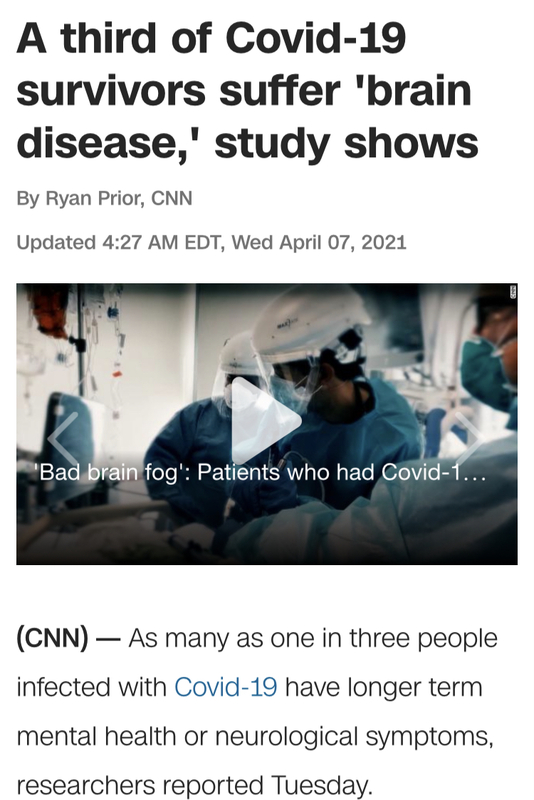 2021-04-07
2021-04-07COVID-19 and the Brain
COVID-19 has gone through a number of classifications. First as a “flu,” then as a “respiratory disease,” then as a “vascular disease,” and is in more recent studies, as a “brain disease.” Some reports are finding that one out of three COVID-19 survivors have mental health and/or neurological issues. This not only informs us of the complexity of COVID-19, but also brings light to the need to continue medical and psychological support of COVID survivors. Some survivors are described as having PTSD, and anxiety disorders are being diagnosed in a number of survivors. Neurologically, many survivors report “brain fog” and other issues. Another unexpected toll the virus takes on those infected. -
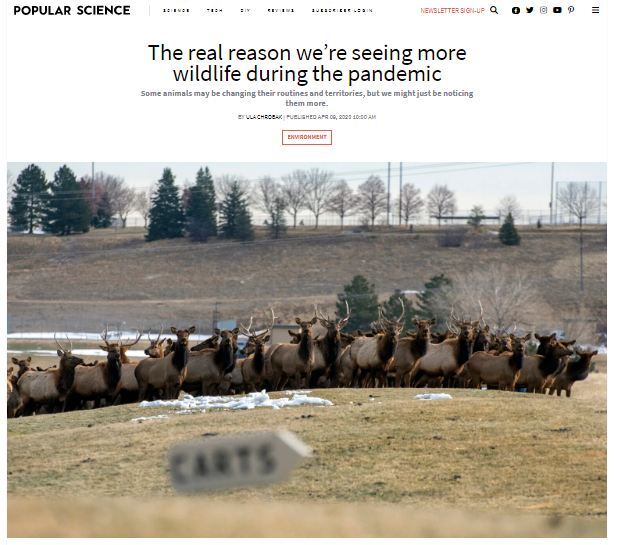 2020-04-09
2020-04-09Why are we seeing more wildlife during the pandemic
This article is important because it discusses why we are seeing more wildlife out and about during the pandemic. They discuss the topic of “is more wildlife out, or are people just noticing wildlife more?” and other topics related to this. This article also discusses the difference between seeing bigger or smaller animals and the reasoning behind it. This article gives a good insight on wildlife during the pandemic and reasons for more sightings. -
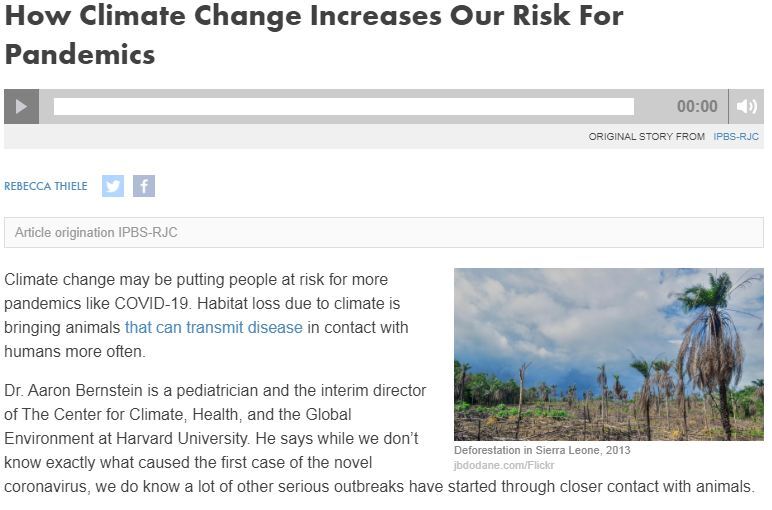 2020-03-24
2020-03-24Climate change, Wildlife, and the pandemic
In this article by PBS it is discussed how climate change, wildlife, and the pandemic all have a connection. One of them being that with more habitats for wildlife being destroyed, the higher risk for contact with wildlife increases which increases the chances of another pandemic. This is a short but informative article and they interview a doctor from Harvard as well who gives his input to this topic. He explains that direct contact with animals is the cause of the pandemic and if we do not do something about this soon, it will just reoccur again. -
 2020-08-06
2020-08-06Widlife Sightings during COVID-19
This journal entry is important because it gives insight as to why the wildlife sightings were important to note during the pandemic. During the pandemic it was noted by many people across the world that wildlife was a lot more active and out. This could be for a variety of reasons, some of the obvious reasons being that there is less human interaction and traffic therefore the wildlife feels comfortable exploring. This journal entry also explains how it may just be that people are noticing wildlife more, not that there is more wildlife. This journal explains how wildlife scientists were able to study them during the pandemic period which can help answer long term questions. -
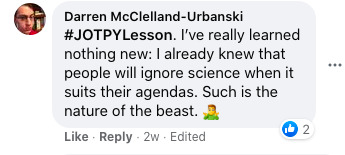 2021-03-23
2021-03-23#JOTPYLesson from Darren McClelland-Urbanski
I’ve really learned nothing new: I already knew that people will ignore science when it suits their agendas. Such is the nature of the beast. -
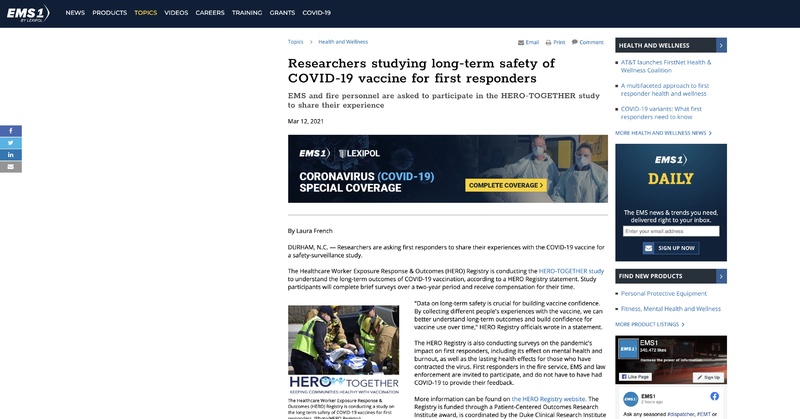 2021-03-12
2021-03-12Long-term Vaccine Effect Research Project
This article is about the Healthcare Worker Exposure Response and Outcomes (HERO) research project. They are trying to understand the long-term effects of the Covid-19 vaccine. The population that they are using is first-responders, who were among the first group to receive the vaccine in most states. The project plans to conduct periodic surveys over a 2 year period. Since this vaccine was produced in record time, and especially the lack of available data to the long term effects, it is an important project. The project also surveys the first responders regarding their mental health during the pandemic. It includes fire fighters, EMS providers, and law enforcement. -
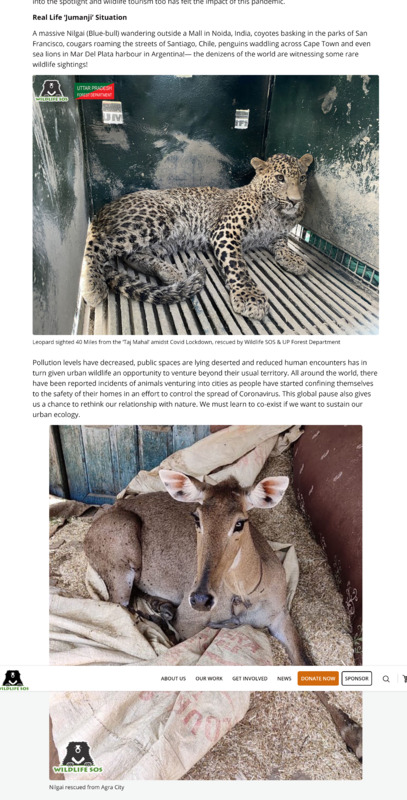 2020-05-13
2020-05-13Real life Jumanji
This website explains how wildlife has changed since the pandemic occurred. They explain how it could be a real life jumanji situation and how pollution levels have decreased. -
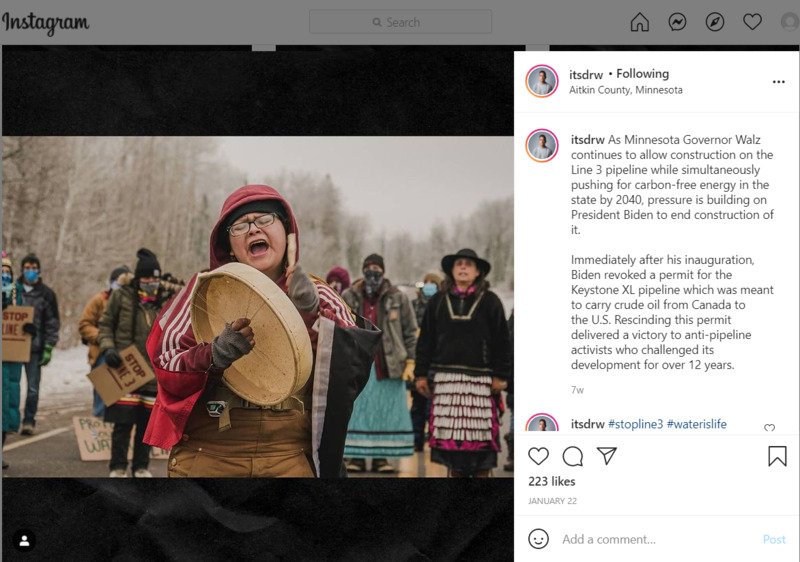 2021-01-22
2021-01-22Construction on Line 3 Pipeline
As Minnesota Governor Walz continues to allow construction on the Line 3 pipeline while simultaneously pushing for carbon-free energy in the state by 2040, pressure is building on President Biden to end construction of it. Immediately after his inauguration, Biden revoked a permit for the Keystone XL pipeline which was meant to carry crude oil from Canada to the U.S. Rescinding this permit delivered a victory to anti-pipeline activists who challenged its development for over 12 years. -
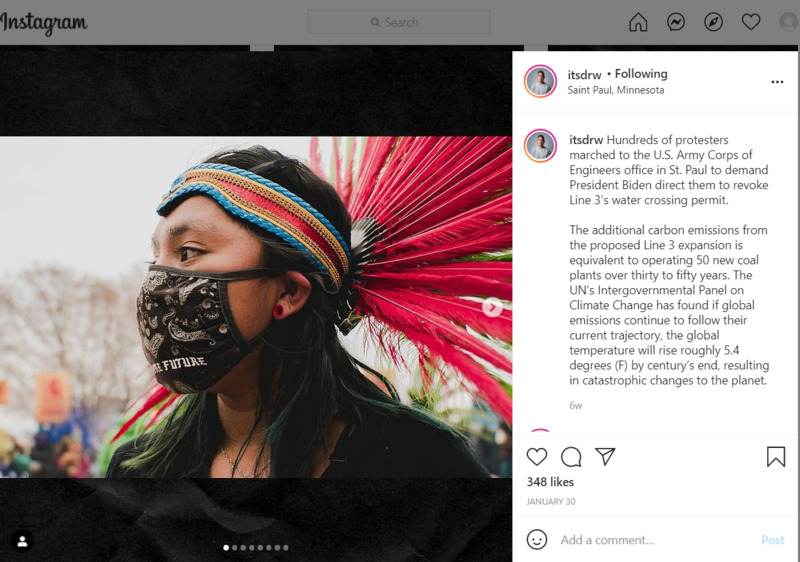 2021-01-30
2021-01-30Protesters March to U.S. Army Corps of Engineers Office
Hundreds of protesters marched to the U.S. Army Corps of Engineers office in St. Paul to demand President Biden direct them to revoke Line 3's water crossing permit. The additional carbon emissions from the proposed Line 3 expansion is equivalent to operating 50 new coal plants over thirty to fifty years. The UN's Intergovernmental Panel on Climate Change has found if global emissions continue to follow their current trajectory, the global temperature will rise roughly 5.4 degrees (F) by century’s end, resulting in catastrophic changes to the planet. -
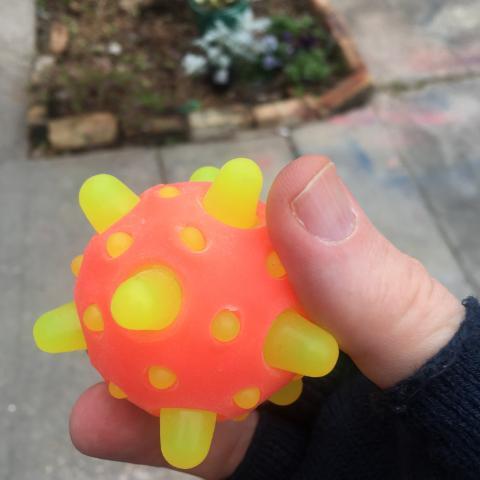 2021-02-14
2021-02-14Coronaland
A coronavirus Mardi Gras throw
